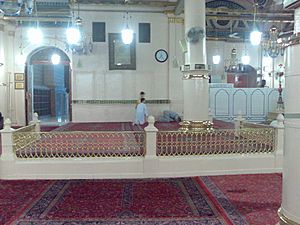Abu Hurayra facts for kids
Quick facts for kids Abu Hurairahأبُو هُرَيْرَة |
|
|---|---|
| Born | c. 603 CE Al Jabour, Arabia (present-day Al Bahah, KSA) |
| Died | c. 681 (aged 77–78) Medina, Umayyad Caliphate (present-day KSA) |
| Resting place | Al-Baqi', Medina |
| Other names | Abd ar-Raḥmān ibn Ṣakhr عَبْدُ الرَّحْمن بْنُ صَخر Servant of The Most Merciful, Son of Sakhr |
| Era | Rashidun, Umayyad |
| Religion | Islam |
| Main interest(s) | Hadith |
| Military career | |
| Allegiance | Muhammad Rashidun Caliphate |
| Service/ |
Rashidun army |
| Commands held | Military governor of Bahrain |
Abu Hurayra (Arabic: أبو هريرة, romanized: Abū Hurayra; c. 603–681 CE) was a very important companion of the Islamic prophet Muhammad. He is known for sharing the most hadith (sayings and actions of Prophet Muhammad). Many Muslims, especially Sunnis, consider him the most reliable narrator of these important stories.
He was nicknamed Abu Hurayrah, which means "Father of a Kitten." This name came from his love for cats. He was also a member of the Suffah, a group of early Muslims who lived near the Prophet's mosque in Medina. Later in his life, Abu Hurairah served as a scholar, governor, soldier, and someone who checked hadith stories. Scholars admired his amazing memory, which helped him remember thousands of hadith.
Contents
Life of Abu Hurairah
Early Life and Conversion
Abu Hurairah's real name was 'Abd al-Raḥmān ibn Ṣakhr. He was born around 603 CE in a region called Al-Bahah in Arabia. His family belonged to the Banu Daws clan.
He became a Muslim through Tufayl ibn Amr, the leader of his tribe. Tufayl had met Prophet Muhammad in Mecca and accepted Islam. Abu Hurairah was one of the first people in his tribe to become Muslim. He then traveled with Tufayl to Mecca to meet Prophet Muhammad. It was around this time that he found a small kitten and kept it in his sleeve, earning him his famous nickname.
Life in Medina
After the hijrah (the migration to Medina), Abu Hurairah lived with other early Muslims in the Suffah. This was a special area near Prophet Muhammad's mosque. He stayed very close to Prophet Muhammad, learning from him and joining him on journeys and expeditions.
Abu Hurairah took part in several important events. He was present at the Battle of Mu'tah, during the Conquest of Mecca, and at the battle of Hunayn. He was also sent as a muezzin (someone who calls Muslims to prayer) to Bahrayn.
Abu Hurairah's daughter married Said ibn al-Musayyib, a famous scholar. Said said he married her to learn more hadith from Abu Hurairah. Another student, Hammam ibn Munabbih, wrote down the hadith he learned from Abu Hurairah in a book called Sahifah Hammam ibn Munabbih. This is one of the oldest hadith collections.
After Prophet Muhammad's Death
After Prophet Muhammad passed away, Abu Hurairah continued to serve the Muslim community. He participated in the Ridda wars, which helped unite the Muslim lands. Later, during the rule of Umar, the second caliph, Abu Hurairah became the governor of Bahrayn.
He was also a qadi (judge) in Medina and gave fatāwā (religious opinions). Abu Hurairah was one of the people who tried to protect Uthman, the third caliph, during his assassination. He continued to be a mufti (someone who gives religious advice) after Uthman's death. In the early Umayyad era, he helped check if hadith stories were real.

Abu Hurairah died in 681 CE, when he was about 78 years old. He was buried in al-Baqi' in Medina. His funeral prayer was led by the governor of Medina. Later, a building called the Mausoleum of Abu Hurairah was built in his honor.
Legacy and Influence
The hadith stories told by Abu Hurairah are very important in Islam. Scholars use them to understand many parts of their religion, like beliefs (aqīdah), laws (fiqh), and explanations of the Quran (tafsīr).
Many famous Islamic scholars, like Ibn Taymiyyah and Ibn Kathir, used Abu Hurairah's narrations in their books. His stories are found in major Quran commentaries and legal rulings.
Abu Hurairah was one of the few companions of Prophet Muhammad who gave official religious rulings (fatāwā). His rulings were so respected that even other companions asked him for advice. The four main Sunni schools of Islamic law rely heavily on his fatāwā and hadith narrations.
Hadith
Abu Hurairah is known for telling at least 5,374 hadith. He continued to collect hadith even after Prophet Muhammad's death, learning from other companions like Abu Bakr and Umar. He himself said that only Abd Allah ibn Amr ibn al-As had more narrations than him. This was because Abd Allah wrote down every hadith, while Abu Hurairah relied on his amazing memory.
Many hundreds of companions and later scholars learned hadith from Abu Hurairah. Some of his famous students include Abd Allah ibn Umar ibn al-Khattab, Ibn Abbas, and Said ibn al-Musayyib. The way he passed on hadith is still studied by scholars today.
Questions about his Narrations
Over time, some people, especially certain Shia scholars, have questioned the number or accuracy of Abu Hurairah's hadith narrations. They suggested that he might have misquoted Prophet Muhammad. Some historical accounts mention that Caliph Umar sometimes warned Abu Hurairah about telling too many stories.
However, the majority of Sunni scholars, both in the past and today, have always considered Abu Hurairah to be a trustworthy narrator. They believe that the criticisms against him are not strong enough. They point out that Abu Hurairah was highly respected and given important roles, like governor and judge, by caliphs like Umar. This shows that he was trusted by the leaders of his time. Scholars also say that the methods used to question his reliability are not always valid according to the strict rules of hadith studies.
In summary, while some doubts have been raised, the mainstream Sunni view is that Abu Hurairah was a reliable and honest companion who played a crucial role in preserving the teachings of Prophet Muhammad.
See also
 In Spanish: Abu Hurairah para niños
In Spanish: Abu Hurairah para niños
- 7th century in Lebanon § Ṣaḥāba who have visited Lebanon
- List of battles of Muhammad


